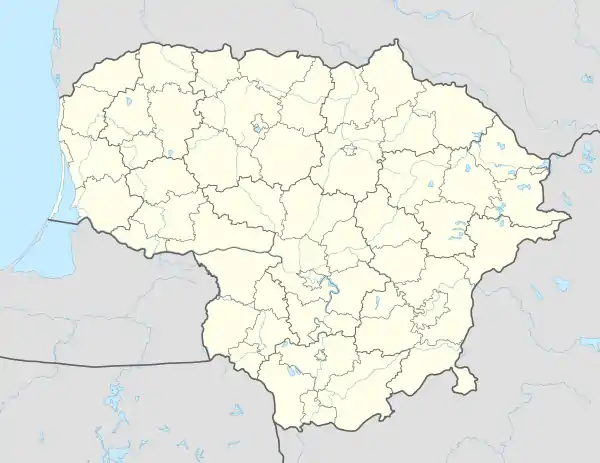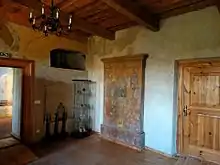Videniškiai
Videniškiai is a historic village in the Molėtai District Municipality, Lithuania. It is located about 8 kilometres (5.0 mi) west of Molėtai.[1] It is situated between the Ukmergė–Molėtai road and the Siesartis River. According to the 2011 census, it had 368 residents.[2] In the 16th–17th centuries, the village was one of the core properties of the Giedroyć family who funded the monastery for the Canons Regular of Penance of the Blessed Martyrs and the Church of St. Lawrence. The monastery honored Michał Giedroyć (died in 1485) who was possibly born in the village and was officially beatified in 2018. The reconstructed monastery now houses a small museum and a library.
Videniškiai | |
|---|---|
Village | |
 Church of Saint Lawrence and memorial stone erected for the 650th anniversary of the village's founding | |
 Coat of arms | |
 Videniškiai Location of Videniškiai | |
| Coordinates: 55°13′00″N 25°16′40″E | |
| Country | |
| County | Utena County |
| Municipality | Molėtai District Municipality |
| Eldership | Videniškiai Eldership |
| First mentioned | 1367 |
| Population (2011) | |
| • Total | 368 |
| Time zone | UTC+2 (EET) |
| • Summer (DST) | UTC+3 (EEST) |
History
A bronze horseshoe-shaped fibula with red enamel was found during archaeological excavations at the center of the town in 1999. The fibula is dated to the 4th century AD.[3] Its unique design was considered for the village's coat of arms.[4]
According to the Palemonid legends, the village takes the name from its founder Duke Vidas (Hurda) Ginvilaitis, grandson of Duke Giedrius and ancestor of the Giedroyć family.[5] The village was first mentioned in written sources in 1367 in a peace treaty of Grand Duke Algirdas and Duke Kęstutis with the Livonian Order. It guaranteed safe passage for merchants from Vilnius to Riga.[6] The village was mentioned in the chronicle of Hermann von Wartberge in 1373 and 1375 when it was attacked during the Lithuanian Crusade.[1]
Its coat of arms was approved by President Dalia Grybauskaitė on 28 August 2018.[7] The coat of arms depict a four-leaf rose which alludes to the Poraj coat of arms used by the Giedroyć family. An inverted chevron represents architectural heritage and reminds of the letter "V" (the first letter of village's name). Its silver color represents the Siesartis river and the green shield represents the beauty of nature.[8]
The village celebrates the traditional annual parish festival in June.[9]
Demographics
The village had 239 residents in 1863, 255 in 1879, 284 in 1923, 282 in 1959, 268 in 1970, 316 in 1979, 403 in 1989, and 415 in 2001.[1]
Education
From the 17th century, the village had a school maintained by the church and monastery. The school had 20 students in 1770 and 48 students (11 nobles, 18 townspeople, and 19 peasants) in 1781. A year later, the number of students dropped to 17 (4 nobles, 7 townspeople, and 6 peasants).[5][10] A small extension was added to the monastery in 1790 to house the school. In 1896, Žemaičių ir Lietuvos apžvalga reported that the village had a Russian primary school. In 1907, a new wooden school building was constructed.[10] In 1949, the former monastery was transformed into a seven-year school. An extension was built in 1958 and the school relocated to a brand new building in 1971–1972. In 1966–1999, the school was a high school.[10] At first reduced to a ten-year school, it became a branch of a primary school in Molėtai in 2013. The branch was closed in 2018. The renovated former school building will be used by a community center, library, and office of the eldership.[9]
Heritage
Castle
According to a story recorded by Maciej Stryjkowski, Duke Daumantas (later confused with historical Daumantas of Pskov), son of Vidas from the legendary Palemonid dynasty, built a castle near Videniškiai. Historians attempted to identify it with the fortified Baltadvaris Castle located about 2 kilometres (1.2 mi) west of Videniškiai. However, archaeological excavations disproved the notion.[11] It is likely built by Matas Giedraitis, Court Marshall of Lithuania, or his son Marcin, Voivode of Mstsislaw, in the mid-16th century. It was known as Mūriniai Videniškiai (Brick Videniškiai) and later as Baltadvaris (White Manor).[6]
History


The first wooden church in Videniškiai was built by Matas Giedraitis in 1547–1549.[12] The church was named after the Holy Trinity and was attended by priests from the Dominican Church of the Holy Spirit in Vilnius.[6] His sons Marcin, Voivode of Mstsislaw, and Merkelis, Bishop of Samogitia, funded a new brick Church of St. Lawrence. Marcin also funded a monastery for the Canons Regular of Penance of the Blessed Martyrs, an Augustinian order, which was completed in 1620.[12] Michał Giedroyć (died 1485) was a member of the Canons Regular of Penance and was venerated for his piousness (he was officially beatified only in 2018).[13] The new monastery was financially supported by revenue from Videniškiai and other gifted land and serfs. A chapel with a crypt was added in 1631 to the monastery church to act as a mausoleum for the Giedroyć family.[12]
The first monastery was a small wooden structure that could house twelve monks, but it became a center of the Canons Regular of Penance in Lithuania. From the very beginning, monastery's superior had the right to wear bishop's insignia (mitre and crosier).[12] The provincial superior and later superior general of the Canons Regular of Penance was based in Videniškiai. The monastery had a novitiate and taught theology. In 1753, philosophy was taught by Michał Olszewski who also served as a vicar.[12] That year he published a Lithuanian-language collection of sermons Broma atwerta ing wiecznasti... (The Gate Open to Eternity) which became very popular and was reprinted at least sixteen more times.[14] The monastery also maintained a parish school (it possibly dates to 1600 when Merkelis Giedraitis left some sums for a school in his last will) and a rudimentary hospital/shelter for the sick and elderly (Lithuanian: špitolė).[12] The church had a choir which owned a separate house in the village.[6]
The church and the monastery were heavily damaged during the Second Northern War (1655–1660).[12] The church was reconsecrated in 1684. In 1750s, two-floor brick monastery building was added. It survives this day. The old wooden monastery buildings continued to house novitiate, refectory, kitchen. They were demolished in mid-19th century.[12] In 1783, Józef Kossakowski, Bishop of Livonia, received a papal bull from Pope Pius VI and seized the monastery and its land. Bishop of Vilnius Ignacy Jakub Massalski and the Canons Regular of Penance sued and recovered the monastery and received cash compensation, but lost the land.[12] After the Uprising of 1831, Tsarist authorities closed all monasteries (except one in Vilnius) of the Canons Regular of Penance in 1832.[15]
The monastery church became a parish church. The former monastery was used as a clergy house and, after World War II, as a school.[12] After Lithuania declared independence, the damaged and neglected building was returned to the parish. Extensive restoration works started in 1994 with financial support by, among others, Michal Giedroyc, a descendant of the Giedroyć family.[16] During the restoration, workers uncovered murals with portraits of monastery superiors. Originally, there were ten murals created c. 1762, but two were lost.[5][16] After the prolonged restoration, a museum was opened in the former monastery on 4 May 2015 (the 530th death anniversary of Michał Giedroyć).[16] The museum hosts educational workshops, including on candle and Christmas wafer making.[9] The church holds a special mass in honor of Michał Giedroyć on the 4th day of every month.[16]
Architecture
The exterior of the church and monastery are reserved, without decorations.[12] The church presbytery has two epitaphs with relief figures that were installed in 1639. The figures are usually identified with the monastery founder Marcin Giedrojć and the first monastery superior Hippolit Rzepnicki, but it is possible that the second epitaph depicts Merkelis Giedraitis.[6] The original early 18th-century church pipe organ has not survived. It was reworked by Wacław Biernacki in the early 20th century but has retained the original casing which is one of the older surviving casings in Lithuania. The organ has five stops.[17]
See also
![]() Media related to Videniškiai at Wikimedia Commons
Media related to Videniškiai at Wikimedia Commons
References
- "Videniškiai". Visuotinė lietuvių enciklopedija (in Lithuanian). Mokslo ir enciklopedijų leidybos centras. 2019-06-19 [2014].
- "Utena county". Results of the 2011 Population and Housing Census of the Republic of Lithuania. Statistics Lithuania. 2013. ISBN 978-9955-797-19-7. Retrieved 2 January 2020.
- Kvizikevičius, Linas (1999). "Archeologijos žvalgomieji tyrinėjimai Videniškiuose 1999 metais" (PDF) (in Lithuanian). Lietuvos archeologijos draugija. pp. 4, 20, 47.
- "Videniškiečiai Heraldikos komisijai siūlys herbo variantą be rožės" (PDF). Vilnis (in Lithuanian). 17 (8091): 5. 6 March 2018. ISSN 1648-4096.
- Virvičiūtė-Rybelienė, Monika (5 July 2008). "Videniškius žinojo ir kryžiuočiai". Voruta (in Lithuanian). 13 (655): 4–5. ISSN 1392-0677.
- Vojevodskaitė, Arimeta (15 May 2003). "Žemaičių vyskupo Merkelio Giedraičio tėviškė". Postilei – 400 (in Lithuanian). Žemaičių kultūros draugijos Informacinis kultūros centras. ISSN 1648-8822. Retrieved 19 January 2020.
- "Dekretas dėl Videniškių herbo patvirtinimo" (PDF) (in Lithuanian). Office of the President of the Republic of Lithuania. 28 August 2018. Retrieved 2 January 2020.
- "Naujųjų metų Išvakarėse - neeilinės Iškilmės Videniškiuose" (PDF). Vilnis (in Lithuanian). 1 (8173): 4–5. 4 January 2019. ISSN 1648-4096.
- Nanartonytė, Inga (26 August 2019). "Videniškių pasididžiavimas – garsios LDK didikų giminės palikimas ir veikli bendruomenė". Lietuvė (in Lithuanian). Retrieved 19 January 2020.
- "Trumpa mokyklos istorija" (in Lithuanian). Videniškių pagrindinė mokykla. 2008. Archived from the original on 28 December 2008.
- Rėklaitytė, Ieva (23 August 2002). "Baltadvario (Mūrinių Videniškių) bastioninė pilis: archeologiniai ir istoriniai duomenys". Voruta (in Lithuanian). Retrieved 19 January 2020.
- Janonienė, Rūta (6 June 2000). "Videniškių buvęs atgailos kanauninkų vienuolynas ir Šv. Lauryno bažnyčia". Lietuvos vienuolynai. Vadovas (in Lithuanian). Vilniaus dailės akademijos leidykla. ISBN 9986-571-39-1.
- Sielepin, Adelajda (2018). "Michael Giedrojć (1420?–1485): A Christian of Timeless Spirituality. Before His Beatification" (PDF). Soter. 65 (93): 39. doi:10.7220/2335-8785.65(93).2. ISSN 2335-8785.
- Vaicekauskas, Mikas (2008). "To Burn or To Republish?: The Fate of the 18th–19th century Lithuanian Bestseller". In Gabler, Hans Walter; Robinson, Peter; Subačius, Paulius V. (eds.). Textual Scholarship and the Canon. Variants. 7. Brill/Rodopi. pp. 9–10. doi:10.1163/9789042032361_003. ISBN 9789042032361.
- Jagminas, Leonardas (2018-08-01) [2002]. "atgailos kanauninkai". Visuotinė lietuvių enciklopedija (in Lithuanian). Mokslo ir enciklopedijų leidybos centras.
- Kaupinytė, Ona (24 April 2015). "Laukia palaimintojo Mykolo Giedraičio stebuklų". Katalikas (in Lithuanian). 8 (227). ISSN 2029-1302.
- Povilionis, Girėnas. "Šv. Lauryno bažnyčia". Istoriniai Lietuvos vargonai (in Lithuanian). VšĮ Vargonų paveldo centras. Retrieved 19 January 2020.
